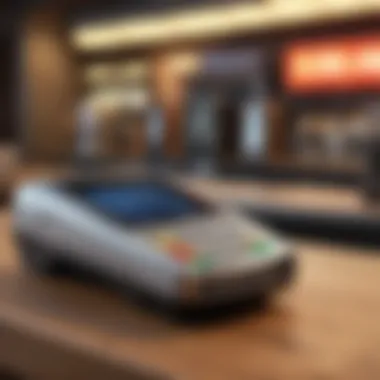Exploring Establishments That Accept Bank Payments


Intro
As the world becomes increasingly digital, the way we handle our finances is evolving too. Traditional cash payments are taking a back seat, allowing bank account payments to steal the limelight. This shift not only highlights convenience but also underscores the need for security in today's monetary exchanges.
Many retail shops, online marketplaces, and service-based platforms now accept direct bank transfers, making transactions more seamless. In this article, we will navigate through various establishments that embrace this payment method, shedding light on the benefits, challenges, and the ever-changing landscape that bank account payments occupy in our lives.
Overview of Financial Products
Definition and Significance
Bank account payments constitute a vital segment of the financial ecosystem. They enable consumers to transact efficiently without relying on credit cards or cash. This can be particularly appealing for those who may carry limited plastic or prefer to avoid incurring debt. The convenience of paying directly from one's bank account simplifies both personal budgeting and transaction records.
Types of Financial Products Available
Different financial products embrace bank account payments, creating a spectrum of options available to users. Here are a few notable examples:
- Retail Transactions: Local stores and big-box retailers commonly support direct bank payments. This can often lead to savings through reduced transaction fees compared to credit transactions.
- Online E-commerce: Websites like Amazon or eBay now allow direct bank payments, giving consumers more freedom in their spending choices.
- Service Payments: Utility companies and subscription services like Netflix facilitate payments directly from bank accounts, ensuring reliable service access without extra hassle.
Key Attributes
Interest Rates and Returns
Payments made directly from bank accounts often do not involve the high interest rates associated with credit card usage. This can lead to better financial management, as consumers avoid accumulating debt. Instead of worrying about fluctuating rates, users can focus on budgeting, a key aspect for individual investors.
Risk Factors Associated with Each Product
Despite the ease and benefits of using bank account payments, there are some risks involved. Factors include:
- Fraudulent Transactions: Cybersecurity threats loom large. Ensuring accounts have secure passwords and monitoring activity can help mitigate risks.
- Overdraft Fees: Making payments without sufficient funds can lead to fees, which can quickly mount up if not managed properly.
"Bank account payments stand at the crossroads between old-school cash handling and the new digital age, offering both a haven from debt accumulation and a pathway for potential risks."
As transactions continue to migrate online, understanding the variety of places that accept bank account payments becomes increasingly crucial for financial enthusiasts and individual investors. By delving into the nuances of this payment method, we can better navigate the landscape of our evolving digital economy.
Preamble to Bank Account Payments
Understanding how payments via bank accounts work is vital for anyone navigating today’s financial landscape. It’s not just a way to exchange money; it reflects a broader shift in how we engage with commerce and services. As consumers increasingly prioritize security and convenience, the ability to pay directly from a bank account offers a plethora of advantages. This article aims to shed light on these benefits, along with the various places where such payments are welcomed.
Understanding Bank Account Payments
Bank account payments involve the direct transfer of funds from one bank account to another. It might sound straightforward, but the mechanisms are often layered with different methods, like ACH transfers or wire transfers.
For example, when a customer makes a purchase at a store using their bank account, the funds are deducted directly from their checking account, providing an immediate and clear transaction trail. This process can also involve automated clearing houses, which streamline transactions between banks, making them faster and often cheaper than traditional credit card transactions.
There are several key components to understand:
- Transaction Types: This includes direct debit, where funds are pulled from a customer's account, or wire transfers, which require authorization each time.
- Settlement Time: Depending on the type of payment method, funds can clear almost instantly or take a few business days. This aspect plays a big role in choosing how to make payments.
- Fees and Costs: While bank transfers typically incur fewer fees than credit card processing, there might be exceptions based on the provider.
Understanding these elements is crucial not only for consumers but also for businesses that rely on bank payments for their operations.
The Role of Bank Account Payments in Modern Transactions
In today's digital economy, bank account payments are more than just an alternative; they are transforming how consumers interact with service providers and retailers alike.
Consider this: Imagine you want to buy grocery items online. With a bank account payment, you can easily check out without needing a credit card on hand. It reduces friction in the purchase process and enhances the shopping experience.
The rise of fintech solutions has further fueled this trend. By offering seamless integration, many companies allow users to link their bank accounts without much hassle. This enables immediate fund transfers, fostering quicker, more efficient transactions.
Additionally, accepting bank account payments can serve as a trust signal to customers. Knowing their data is secure and the transaction is reliable makes people more comfortable. This builds a strong relationship between businesses and consumers, reflecting the growing preference for direct payments over credit card transactions.
"With bank account payments, the notion of transactional security meets unprecedented convenience, reshaping consumer habits at every turn."
Moreover, as we venture deeper into the age of digital banking, the reliance on bank payments will only intensify. Online marketplaces thrive as they adapt to these payment methods, crafting an ecosystem that benefits all parties involved. Hence, recognizing the value of bank account payments is essential for anyone engaging in today’s commerce.
Types of Establishments Accepting Bank Account Payments
Understanding the types of establishments that accept bank account payments is key to comprehending the broader landscape of financial transactions today. This section aims to delve into the different venues—both physical and virtual—that incorporate such payment methods, thereby illustrating their significance in enhancing accessibility and convenience in the marketplace.
Retail Outlets
When it comes to retail outlets, the range is vast. Grocery stores like Kroger or Walmart have begun to embrace bank account payments, allowing customers to make direct deductions from their bank balances rather than relying solely on credit cards. This process works well for those who prefer to stick to their financial plan without dipping into credit lanes. Such options have also expanded to smaller local shops, offering community members flexible payment methods. In an era where impulse buying often tempts shoppers, the ability to pay directly from their bank accounts may help many balance their budgets better.
In addition, utilizing bank account payments in retail settings often brings lower transaction costs for both customers and store owners. Rather than passing on hefty credit card processing fees, shops have an incentive to adopt this method, thereby potentially lowering product prices.


E-commerce Platforms
The digital marketplace has revolutionized how consumers shop, and e-commerce platforms are at the forefront of this transformation. Websites like Amazon and eBay now provide options for users to link their bank accounts directly for seamless transactions. This shift is particularly significant in the wake of increasing online fraud concerns, as bank account payments can offer a layer of security that traditional credit cards might not always guarantee.
It’s noticeable that many consumers appreciate the ease of keeping their spending accountable without multiple accounts to juggle. By using direct bank payments, individuals can navigate purchases without the worry of overspending on credit. Furthermore, e-commerce platforms that accept bank payments often streamline the checkout experience, making it quicker and easier for customers, promoting higher conversion rates.
Service Providers
When talking about service providers, the picture broadens significantly. Utility companies like AT&T or Comcast now actively accept bank account payments, making the process of paying bills more efficient. Customers benefit as they can manage larger expenses like internet and electricity bills directly from their bank balances. This not only simplifies budgeting but also reduces the risk of late payments, as people can set up automatic transactions that ensure bills are settled on time.
Additionally, subscription services like Netflix and Spotify have jumped onto the bank payment bandwagon. This adjustment allows users the option of withdrawing directly from their accounts rather than using credit that can lead to overspend without a person even noticing.
"The adoption of bank account payments across different establishments reflects a growing trend in simplifying financial transactions, enhancing user experience while also providing imbedded security measures."
The varying establishments that accept bank account payments illustrate a notable shift towards a consumer-friendly approach that prioritizes flexibility and financial responsibility. In following sections, we will delve deeper into the advantages and innovations related to this payment method.
Advantages of Using Bank Account Payments
In a world where transactions are increasingly moving online, understanding the advantages of using bank account payments becomes essential. This payment method is not just a convenient option; it also plays a crucial role in shaping how we manage our finances. The benefits stretch far beyond ease of use, weaving into concerns about security, cost, and access that individuals and businesses alike prioritize today.
Increased Security
When it comes to financial transactions, security is paramount. Paying via a bank account often offers a layer of protection that other forms of payments simply do not provide. In a world rife with cyber threats, bank account transactions can be fortified with various security protocols that minimize the risk of fraud.
Unlike credit card transactions, which can be susceptible to unauthorized use, bank account payments often require more verification. For instance, the completion of a bank transfer usually mandates two-factor authentication, adding a critical safeguard. In addition, bank transactions are well-regulated, providing users with recourse in the event of fraudulent activity.
"Security isn’t just a buzzword; it’s a lifeline in the realm of online payments."
Convenience and Accessibility
Let's face it: nobody enjoys the hassle of digging through their wallets or waiting for a card to process. Bank account payments streamline the process, making transactions seamless. One can execute payments directly through apps on their phone or a simple click on a website, which allows users to send and receive money from virtually anywhere with internet access. This level of convenience can’t be overstated, especially in today’s fast-paced world.
Moreover, bank account payments have become increasingly ubiquitous, which means more businesses are adopting this payment method. With various services accepting direct bank transfers, users can enjoy the ease of managing payments without the added burden of carrying physical payment instruments.
Lower Transaction Fees
Another appealing aspect of bank account payments is the lower transaction costs associated with them. Many financial institutions offer competitive rates for online banking transactions, making this an attractive option for both consumers and businesses. Unlike credit cards, where transaction fees can sometimes add up quickly, bank transfers often involve minimal fees or none at all, especially when dealing within the same bank.
This is particularly beneficial for larger transactions where even a small fee can translate to a significant amount lost. Thus, both individual investors and businesses can save substantial money over time by opting for bank account payments.
Limitations Associated with Bank Account Payments
The discussion of bank account payments wouldn’t be complete without examining their limitations. Even though these methods have carved out a significant role in the financial landscape, they are not without drawbacks. Understanding these limitations is essential for individuals and businesses alike, as it allows them to make informed decisions about their payment methods. This section highlights key elements that warrant careful consideration.
Potential Delays in Processing
When it comes to bank account payments, one of the most prominent issues is the potential for delays in processing. Unlike credit card transactions that tend to be approved in real-time, bank transfers sometimes resemble a game of waiting. When you send money from your bank account, it typically goes through a series of checks and balances, which can lead to delays, especially during busy times or weekends. This lag can be frustrating for consumers and businesses alike, especially when immediate payment is necessary.
For instance, if a customer attempts to pay their utility bill close to a due date, a processing delay might result in late fees or even service disruption. Therefore, both payers and payees should have clear communication about expected processing times to manage their expectations and avoid any surprises down the line.
Availability of Services
Another limitation that is worth noting is the variability in the availability of services that accept bank account payments. Not every retailer or service provider is on board with this payment method. While major players like Amazon and Walmart have embraced bank payments, many smaller businesses may not offer such options due to technological constraints or cost considerations.
Moreover, geographical factors can also play a role. In some regions, certain businesses might not be equipped to handle bank account transactions, leaving customers with limited choices. This highlights the importance of doing your homework before depending entirely on bank account payments. Knowing your options in advance can save you from inconvenience and frustration later on.
User Privacy Concerns
User privacy is a significant concern with bank account payments, and it should not be overlooked. While many consumers value the convenience that comes with making payments directly from their bank accounts, they may also be wary of privacy issues. Each transaction potentially involves sensitive information being shared, such as bank account numbers and personal identification details.
Even reputable establishments are vulnerable to data breaches; thus, it is essential for users to be mindful of where and how they share their information. A common phrase in privacy advocacy circles is, "If you’re not paying for the product, you are the product." In this context, understanding the implications of sharing personal data becomes paramount. Businesses that accept bank payments should ensure they have ironclad security measures in place and communicate these measures transparently to instill confidence in their customers.
"The trust of your customers is like a fragile glass. Once broken, it takes time to rebuild."
In summary, while bank account payments provide numerous benefits, recognizing their limitations allows individuals and businesses to navigate the financial landscape more effectively. From understanding potential delays and service availability to being vigilant about privacy, a comprehensive approach to these payment methods is vital.
Popular Retail Outlets Accepting Bank Account Payments
Understanding where bank account payments are accepted, especially at retail outlets, provides crucial insights into how transactions are evolving. For many, the convenience of simply transferring funds directly from a bank account for everyday purchases is becoming a go-to option. This method not only simplifies the payment process but is also fuelling a shift toward digital finance. Different retail settings embrace these payment methods, creating a more inclusive environment for consumers of all backgrounds.


Major Grocery Stores
Grocery stores are the backbone of our shopping habits. Stores like Kroger, Safeway, and Walmart are increasingly accommodating bank account payments, recognizing the need for agility in transactions. Many major grocery chains have integrated systems that directly link to a consumer's bank account for easier checkouts. This streamlined approach allows shoppers to avoid fumbling with cash or swiping cards, retaining focus on their shopping trips. As many consumers prefer managing their budgets directly from their accounts, offering these services becomes a win-win for both the shoppers and the stores, fostering customer loyalty and satisfaction.
Direct bank transfers are shaping the future of grocery shopping, making it both easier and more secure.
Department Stores
Department stores such as Target and Macy's are also jumping on the bandwagon. Aside from the traditional credit card options, these retail giants are now starting to let customers use bank account payments at checkout. This modality not only increases the speed of transactions but also caters to people who might prefer not to deal with credit card debt. Budget-conscious consumers, particularly, find this mode of payment beneficial. In addition, there is a growing trend where these businesses reward customers who opt for bank payment options, sometimes in the form of discounts or loyalty points, further incentivizing the switch.
Local Businesses
Even small enterprises benefit from accepting bank account payments. Local cafes, boutique shops, and service providers are making the move to accept direct bank transfers. For them, the overhead costs associated with merchant accounts can be a burden. By allowing payments through bank accounts, these businesses often cut down on transaction fees. Additionally, loyal customers appreciate the option, enhancing community ties. Small businesses can also adapt easily to any shifts in how customers prefer to transact, ensuring that they meet their clientele's demands directly.
E-commerce Platforms Accepting Bank Payments
E-commerce platforms represent a significant frontier in the realm of transactions facilitated by bank account payments. The rise of digital shopping has altered how consumers interact with goods and services. Understanding this aspect is cricial as it influences how businesses strategize their payment solutions and how customers choose to spend their money online.
The convenience and versatility of bank account payments on these platforms are undeniable. For one, they provide a secure method for customers to make sizable purchases without the risk commonly associated with credit cards. Unlike credit, where one might end up swimming in debt, using a bank account typically means spending only what one has, which can foster better budgeting practices.
Moreover, these platforms often incorporate various safeguards. Encryption technology ensures that sensitive information travels securely over the internet. Customers can rest easy knowing that their financial details are tucked away safe as a bug in a rug.
Marketplaces
Marketplaces like Amazon, eBay, and Etsy have transformed the way individuals and businesses interact in the digital space. These platforms allow vendors from various backgrounds to connect with potential buyers, making for a rich tapestry of products ranging from handmade goods to high-tech gadgets. Each of these marketplaces has its own protocol when it comes to accepting bank payments, which often involves third-party services for added security.
Here are a few benefits and considerations for buyers using bank payments on marketplaces:
- Straightforward Transactions: Users can seamlessly link their bank accounts for easy checkout.
- Budget Control: Helps in managing spending effectively without lending pressure.
- Dispute Resolution: Most marketplaces have favorable policies for handling disagreements, protecting the consumer’s interests.
But with all that glitters, there are shadows too. Not every seller on these platforms is above board, which necessitates keen discernment from buyers when selecting products.
Online Service Providers
The surge in digital services, ranging from Netflix to online tutoring platforms, illustrates another facet of e-commerce. These service providers have begun to integrate bank account payments into their systems, enhancing the payment landscape significantly.
Using bank payments simplifies access to a variety of services while maintaining user trust. Here’s a rundown of key considerations:
- Recurring Payments: Programs like Netflix allow customers to schedule monthly payments directly from their bank accounts, ensuring consistency.
- Ease of Use: For many users, the process is as simple as setting it and forgetting it – once linked, there's no need to fuss over repeated transactions.
- Economic Choices: With many online services becoming painfully competitive, users can take advantage of tailored subscription models that fit their budget better.
"E-commerce platforms are the new gateways to commerce. They're reshaping our shopping habits, emphasizing the importance of secure payment options like bank transfers."
To sum it all up, e-commerce platforms that accept bank payments are reshaping how we shop and pay for goods and services. With their emphasis on security and consumer-friendly options, they play a pivotal role in today’s financial landscape.
Service Providers Utilizing Bank Account Payments
Service providers play a crucial role in the financial landscape, utilizing bank account payments as a primary mode of transaction. The significance of this topic can’t be understated. It encompasses various domains including utilities and subscriptions, where convenience and security are paramount.
The ability to leverage bank account payments means consumers can enjoy seamless transactions without the hassle of frequent card swipes or having to carry cash. For many, especially in the digital age, a bank account is the anchor of their financial dealings.
Utility Companies
Utility companies, such as American Electric Power or Comcast, have increasingly adopted bank account payment systems. Consumers often have no choice but to pay monthly bills for services they rely on, making the convenience of bank account payments essential.
Utilizing this payment method allows users to automate their payments, ensuring they never miss a due date and face late fees. Setting up automatic deductions right from one’s bank account allows for a streamlined approach where users can forget about the particulars of bills and focus on their daily routines instead.
Some key benefits of using bank account payments with utility providers include:
- Timely Payments: Automatic transactions help in paying bills on time, preventing disruptions in service.
- Less Hassle: Eliminates the need for writing checks or making manual payments each month.
- Expense Tracking: Customers often receive electronic statements, which makes it easier to manage budget and account for utility expenses.
Unfortunately, there's a downside; while bank account payments enhance convenience, they also present challenges. Users must ensure they have sufficient funds as overdrafts can incur hefty fees, contributing to financial strain.
Subscription Services
Alongside utilities, subscription services have taken the plunge into these payment methods as well. This could range from streaming platforms like Netflix to subscription meal kits like Blue Apron. As the culture shifts towards subscriptions for everything from entertainment to grocery delivery, the speed and efficiency offered through bank account payments are increasingly appealing.
Many users prefer subscribing through their bank accounts due to the ease of setup and the ability to manage recurring payments without being burdened by unnecessary notifications. It creates a sense of continuity in managing their subscriptions.
Benefits of using bank account payments for subscriptions include:


- Simplicity: Once set up, payments occur seamlessly without the need for manual intervention.
- Cost-effective: Often, businesses encourage the use of bank account payments by providing discounts or waiving transaction fees.
- Control: Users can access online portals offering detailed views of upcoming payments, making budget management simpler.
However, the automatic nature of these payments can lead to complacency. If one's preferences change, the ongoing charges may slip through the cracks, leading to unwanted charges on the account. As such, it’s essential for users to review their subscriptions periodically.
"In today's fast-paced world, choosing bank account payments for services makes financial management smoother and interruptions are kept to a minimum."
Both utility companies and subscription services highlight the dual-edged nature of bank account payments: offering benefits that cater to modern consumer needs, while also requiring a degree of vigilance to avoid slipping into oversight of automatic charges. This is the balancing act expected from consumers utilizing these methods.
Innovations in Bank Account Payments
Innovations in bank account payments have become a cornerstone of modern financial transactions. As technology evolves, so too does the convenience and efficiency associated with how individuals and businesses manage their money. Innovations in this arena don't just represent a trend; they signify a substantial shift in how people engage with their finances, shaping the future of commerce in ways once thought unimaginable.
Fintech Solutions
Fintech companies have been at the forefront of changing how bank account payments are processed. With a focus on user-friendly interfaces and enhanced security features, these entities are simplifying transactions. For instance, platforms like Venmo and Zelle enable users to send and receive money directly from their bank accounts without requiring cash or checks. This change not only speeds up the payment process but also minimizes the risks associated with carrying physical money.
Some key benefits of fintech solutions include:
- Instant Transactions: Money moves swiftly, often in real-time, eliminating the waiting period users might face with traditional methods.
- Lower Fees: Fintech players usually offer competitive rates, frequently lower than traditional banks.
- User Control: Enhanced dashboards and tracking tools allow users to manage their finances easily, fostering better financial health.
The rise of fintech solutions indicates a move toward more personalized, customer-centric services in the banking sector. As these applications become increasingly integrated into everyday spending, they empower consumers by providing greater flexibility.
Integration with Mobile Applications
Integration with mobile applications is yet another game-changer in managing bank account payments. Nearly everyone carries a smartphone, and banks are capitalizing on this. Mobile banking apps, often equipped with biometric security, allow users to authorize payments, view account balances, and manage transactions all from the palm of their hands.
Several considerations come into play:
- Accessibility: This availability makes it easier for small businesses and consumers to engage in transactions on the go.
- Personal Finance Management: Many apps offer budgeting features that help users track their spending habits, turning bank accounts into tools for financial wisdom.
- Enhanced Security: Using multi-factor authentication and so-called "invisible" security processes, mobile applications provide an extra layer of safety during transactions.
The trend reflects a broader shift towards a cashless society. As bank account payments become more integrated into mobile applications, the way people perceive and conduct transactions continues to evolve.
"Innovative solutions in bank payments not only simplify transactions but also build a bridge towards a more sustainable economy by promoting efficiency."
Through innovations in both fintech solutions and the integration of these services within mobile applications, the landscape of bank account payments is positioned for significant future growth. The intersection of these developments not only improves the customer experience but also encourages broader participation in the financial ecosystem.
Future Trends in Bank Account Payments
The landscape of bank account payments is evolving faster than a rabbit on a date. As technology shifts gears, it’s imperative to understand the future of these payment systems. Discerning the trends can provide customers and stakeholders a glimpse into how transactions will be facilitated going forward. Today's digital environment demands agility and adaptability, leading to innovations that not only improve user experience but also expand accessibility.
The Rise of Digital Banking
Digital banking is not just a trend, but a profound transformation. It reshapes how we manage our money, and this shift is reflected in the acceptance of bank account payments across numerous platforms. More consumers are inclined to open digital-only accounts, attracted by lower fees and higher convenience. The flexibility of banking through apps means customers can transact anywhere, anytime, as long as they have internet access.
Moreover, banks and fintech companies offer seamless integration of payment processing, allowing users to conduct transactions with just a few clicks. This change in the way services are provided fosters a user-centric approach, prioritizing ease and security. For instance, Zelle and Venmo have changed the way people perceive money transfer: it’s instant, simple, and connected to your bank account directly.
“Digital banking is opening doors that traditional branches could never imagine.”
Under this umbrella, security technology also plays a significant role. Advanced encryption methods and biometric authentication are becoming standard features, reassuring users that their funds are secure. This uptick in security is a direct response to the rise of cyber threats, ensuring that users can bank on their trust in these financial services.
Changes in Consumer Behavior
As much as technology drives trends, it’s often the consumers that set the pace. The way people interact with money is shifting towards a more digital-centric method. Younger generations, particularly millennials and Gen Z, want immediacy and ease. They tend to prefer apps and online services over traditional bank visits, representing a change in norms that has significant implications on how businesses and service providers operate.
Typical behavior patterns now show that consumers are comfortable connecting their bank accounts to multiple platforms for shopping, bill payments, and even peer-to-peer transactions. Brands that adapt to these preferences often gain a competitive edge. For instance, subscription services like Spotify now offer options to pay directly via bank account, enhancing the user experience with quick, hassle-free transactions.
Additionally, the pandemic accelerated digital adoption. E-commerce boomed, nudging consumers to embrace online transactions. Wallets began to vanish, replaced by phones and apps. The trend is clear: consumers want everything integrated into their mobile devices. This growing reliance on technology reinforces the need for systems that facilitate bank account payments effortlessly as habits become entrenched.
The End
In the realm of financial transactions, the significance of places that accept bank account payments cannot be understated. They stand as pillars of convenience, ensuring that individuals have seamless avenues to transact without the constant dependence on credit or debit cards. This article has navigated through a landscape rich with various types of establishments — from neighborhood grocery stores to expansive online marketplaces — all of which embrace bank account payments.
Final Thoughts on Bank Account Payments
Adopting bank account payments presents numerous advantages. First, the security these transactions offer is solid. Unlike cash transactions that could vanish in a heartbeat, digital payment methods connected directly to bank accounts generally come with heightened monitoring and fraud protection. Then, there’s the convenience associated; one can easily pay bills or shop online with just a few clicks, steering clear of the hassles of cash and coins.
Moreover, the cost-efficiency cannot be ignored. Many retailers and service providers have lower transaction fees for bank account payments compared to traditional card payments, which can chip away at one's budget over time.
However, it's crucial to remain aware of potential drawbacks. As highlighted earlier, the processing delays might not align with urgent needs, and privacy concerns can loom large in our increasingly interconnected digital world. Understanding these factors helps in making informed decisions.
As we step into an evolving financial future, the trends show that bank account payments are not just a fleeting fad. With the continuing rise of digital banking and changes in consumer behavior, these transactions appear to take root firmly in the backbone of commerce. The bottom line is clear: being informed about bank account payments not only enhances financial literacy but also empowers individuals to make strategic choices that can positively impact their financial journeys.
"In mastering the art of contemporary payments, one unlocks doors to not only convenience but also greater financial autonomy."
Understanding and utilizing bank account payments signifies more than just a method of transacting; it embodies a shift towards a streamlined financial ecosystem that prioritizes efficiency and security.







